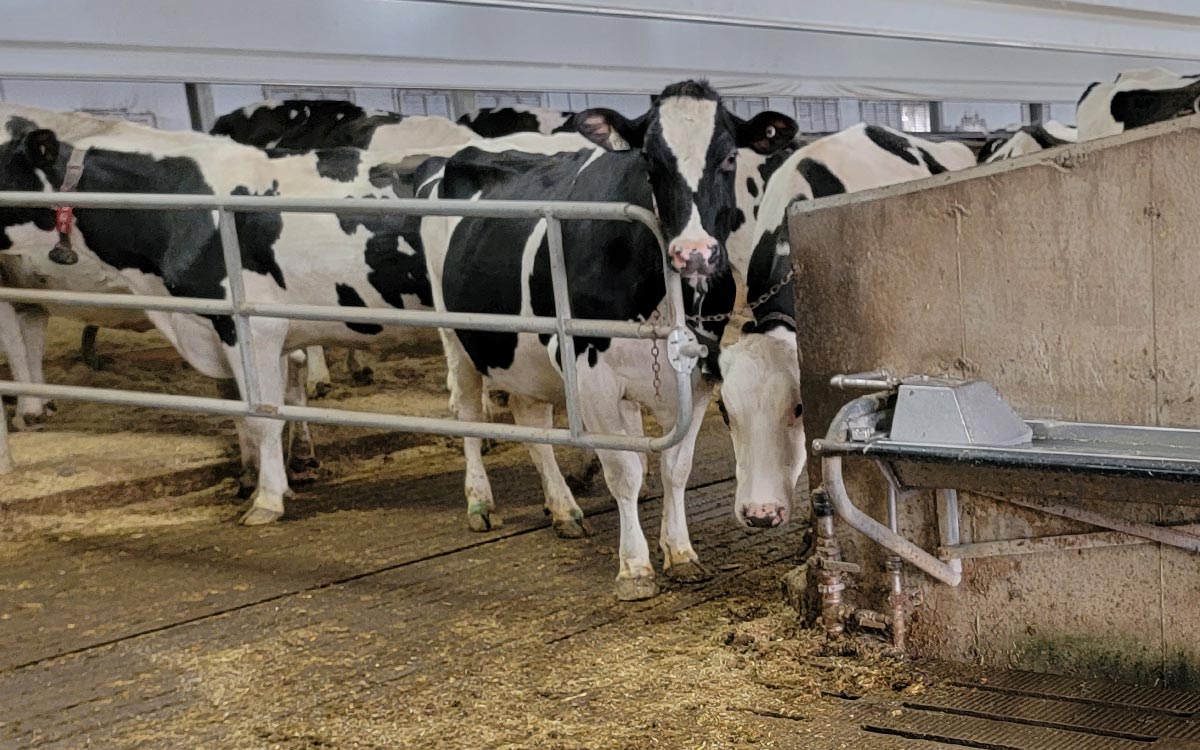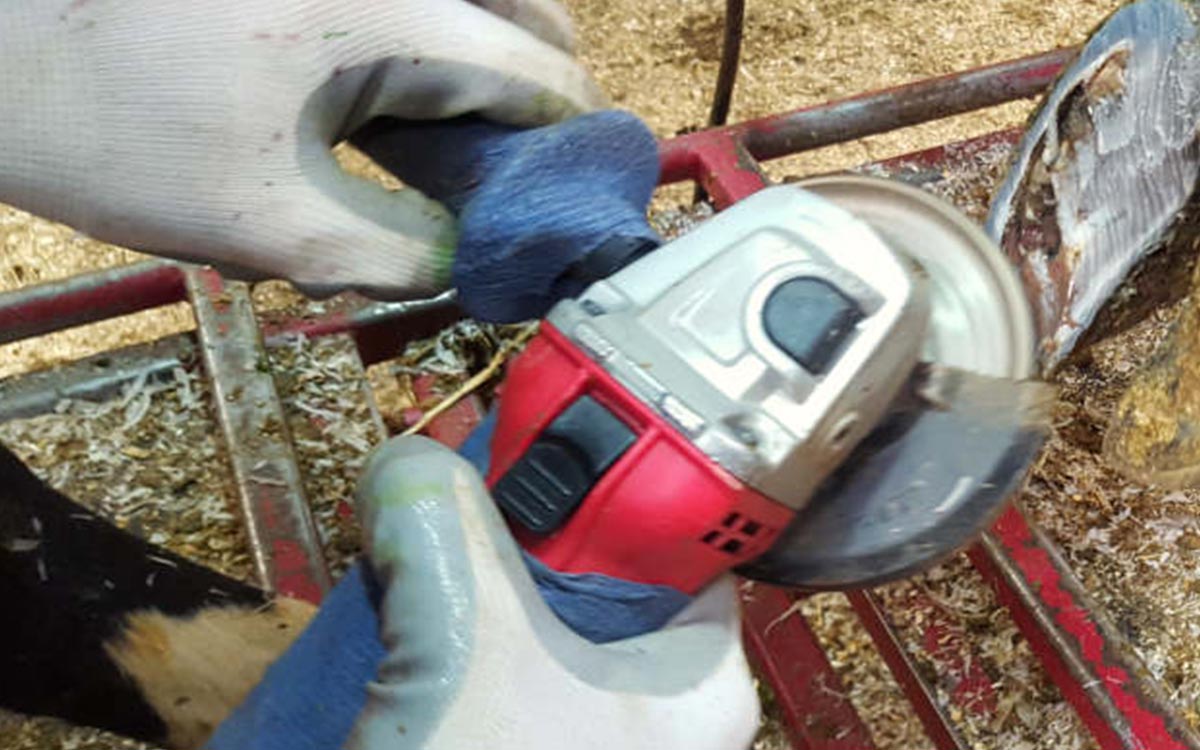Applying a bandage to a cow’s foot is an essential tool for hoof care success. I’ve applied thousands of them during my trimming years and would like to share different options, to-dos, and viewpoints about using bandages on a cow’s hoof. Applying a bandage to treat a cow’s hoof problem is relatively easy and straightforward. There are a few important points to watch for:
Lame cows – do we use bandages or not? Putting a bandage on a cow with foot rot is working against the healing process. There is often much swelling in the entire foot, and the wrap will be too tight and restricting blood flow. With foot rot, there is discharge of fluid (puss), which needs to drain away. Once the bandage is applied, the draining stops, and the swelling gets worse. In general, a veterinarian needs to be involved for foot rot to prescribe an intermuscular antibiotic. The entire protocol on foot rot is described in this blog post: Dairy cow lameness: Foot rot vs. Hoof rot Laminitis-related hoof problems like sole ulcers and white line lesions are easily fixed with balanced trimming or applying a hoof block. The bandage has no place in this treatment protocol and does potentially more harm than good.
- Diagnose the hoof disease and get familiar with the treatment protocols.
- Which steps should I follow when installing the bandage?
- Be careful not to apply the bandage too tight.
- How will you remove the bandage safely and on-time?
Diagnose the hoof disease and get familiar with the treatment protocols.
When your cow is lame, it is not that you automatically need to apply a bandage or wrap. Some hoof problems need proper hoof trimming by using a hoof knife or grinder. For example, when the diagnosis is that the cow has foot rot, I would be very reluctant to apply any wrap. The only hoof problem where I would wrap is when treating digital dermatitis (DD) or hairy warts. This hoof disease will need a treatment protocol that ensures that the product stays on the wound for a prolonged time. Many studies prove that proper wrapping with a bandage increases the cure rates for DD. In the table below, you’ll find different hoof diseases with corresponding treatment procedures. It is not an all-inclusive overview, but it gives a general guideline on the proper and successful use of bandages.| Hoof disease | Use bandages? | Description of the treatment protocol |
| Digital dermatitis (DD, warts, hairy heal, fungus) | Yes | Treatment with Intra Hoof-fit Gel with a wrap for 3 days |
| Sole ulcer – double sole | Not needed | Trim and if needed, block the healthy claw |
| White line defect | Not needed | Trim and block the healthy claw |
| Foot rot – foul-in-foot | No | Trim the hoof. See foot rot protocol |
Which steps should I follow when installing the bandage?
- After properly trimming the hoof, you need to be sure that the area is relatively clean of mud or manure. Washing the entire foot with water is overdoing it, though – the water will fill the pores of the skin and will limit penetration from the medication. The best way I have found to be successful is to use a dry hand towel or paper towel to clean the area. I have also seen others use an air hose, but not all facilities have compressed air by the hoof trimming chute.
- Brush the Hoof-fit Gel in between the two claws and make sure to have it reach the front area and the rear of the hoof. This procedure ensures that all areas are covered without missing critical areas.
- Use some padding to wick moisture away from the treated area. I also purchased bundles of facial pads at Walmart for $1.97 – that way, you have cotton padding that cushions the wound. Others use a paper towel or Kleenex, but the small investment in the facial pads is well worth it. Before applying the wrap, I’d add a bit of Hoof fit Gel to the pad to optimize coverage.
- Gently put the padding to the wound and start using the Intra Tape as your bandaging material. Below are some pictures to show the steps for the application.
Be careful not to apply the bandage too tight.
How tight can a bandage be put on the foot? It is often experience that will teach you the correct application. As a general guide, I would say that you need to be able to insert your finger in between the bandage and the foot. The primary purpose of a wrap is to keep the medication in place without further damage to the hoof. In 2018, I interviewed four hoof experts from Canada and Sweden. The general takeaway was that “you should be able to get two fingers between the wrap and the skin. It’s important to have the wrap half on the skin and half on the hoof to reduce its tightness.” I have come across wraps that were too tight and restricted blood flow to the hoof. It can also happen that unforeseen swelling occurred after the bandage was applied, wherefore the farmer also needs to monitor the cows after trimming. Remember, a wrap is a tool that is temperately used to treat a hoof disease, but may not become a source for a next hoof problem to develop. Needless to say, but it has happened that the bandages were not removed nor monitored on time. Such “accidents” often cause more harm than the original problem for which the wrap was initially applied. Please be careful and use bandages as a tool, which brings excellent success when used correctly. One other important point that we should keep in mind is: don’t wrap a hoof when the chance of staying on is significant. What I mean is this: if a cow is being dried off and removed from the herd for two months, don’t chance a wrap! There is a possibility that the bandage stays on for too long and does more damage than good.How will you remove the bandage safely and on-time?
The general recommendation for the non-antibiotic treatment for digital dermatitis with Intra Hoof-fit Gel is that the bandage is removed after 3-4 days. This timeline has proven to be successful and also allows rechecking the hoof and determining if a second treatment is needed – this time without a bandage. The question I often get is, how do I get the bandage off again? The best method would be to lift the foot, inspect the area and retreat if needed. The more practical approach is to remove the wraps in the milking parlour or headlocks by using a new innovative tool: the WrapAway. This bandage remover tool is designed to be adapted to your barn setting and fits different extension poles. The WrapAway has a threaded end, and a painters-pole or broomstick can be easily screwed in to fit your needs. A correctly installed wrap is not too tight, and the WrapAway tool easily slides between the hoof and the bandage, making removal a breeze. The blunt tip avoids damage to the cow’s foot, and there is no more bending for the user. The WrapAway can be used under all angles and is easily sharpened when it gets dull.
Record Keeping Worksheet
Keep track of your herd’s records with ease and precision.. Web and print-ready options included!



